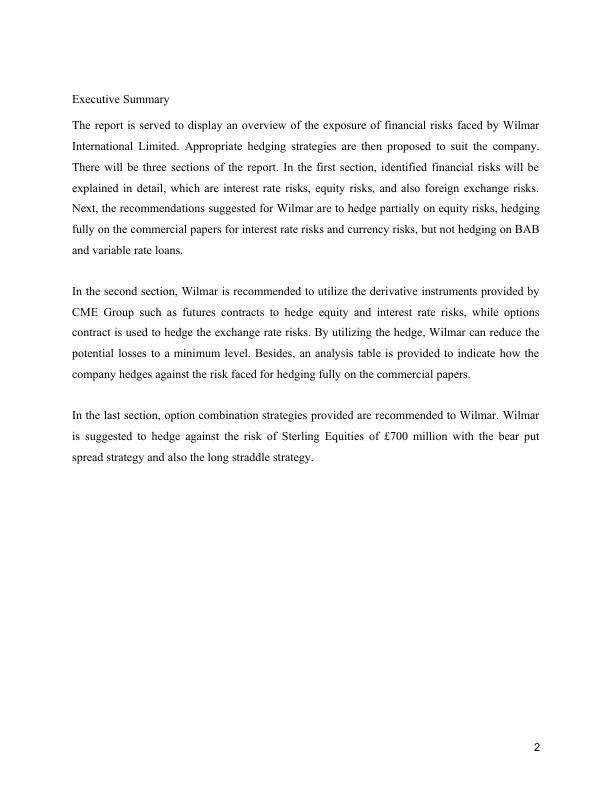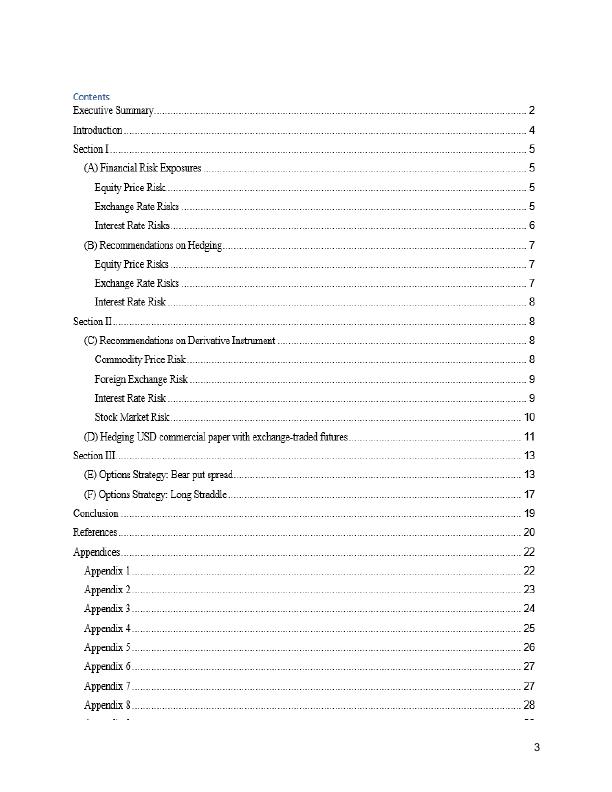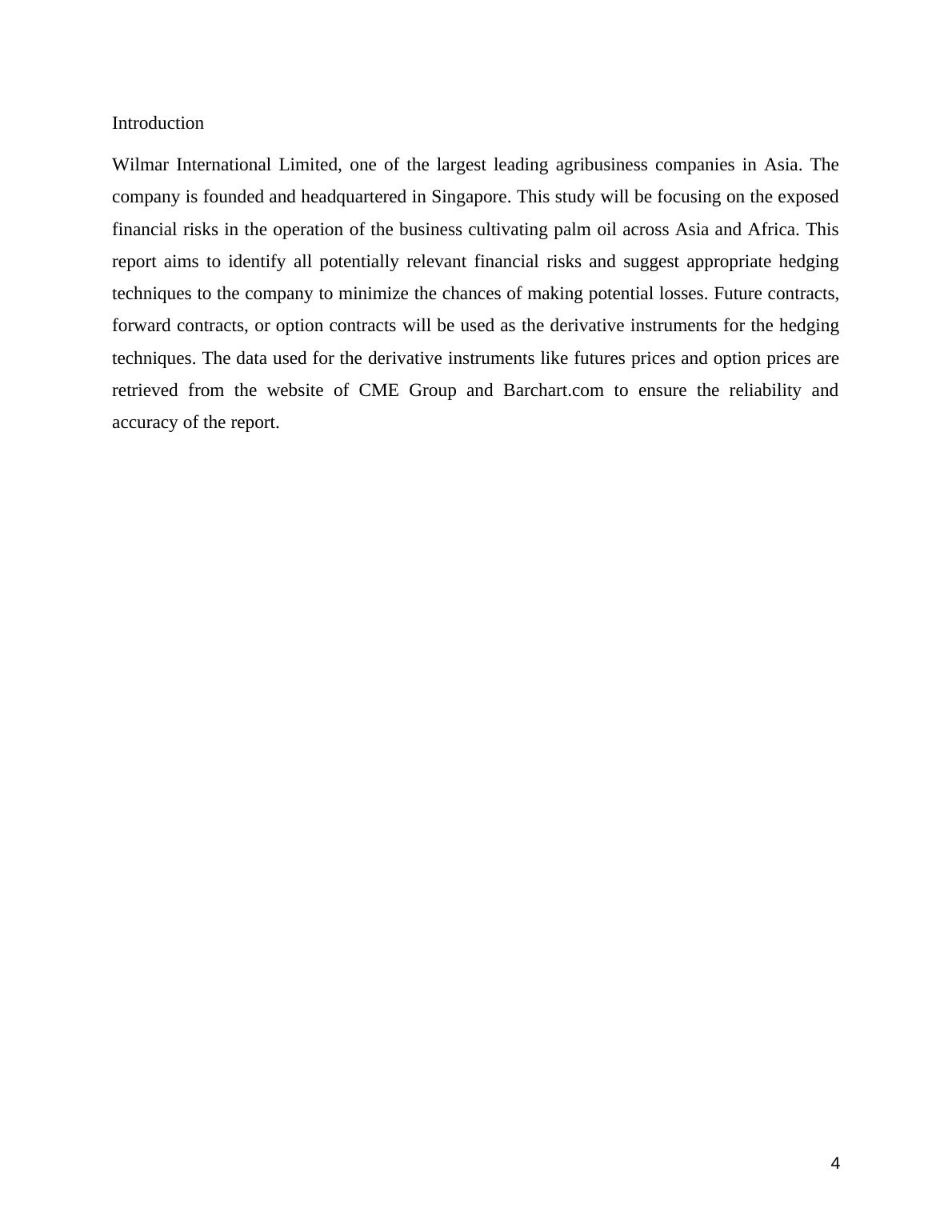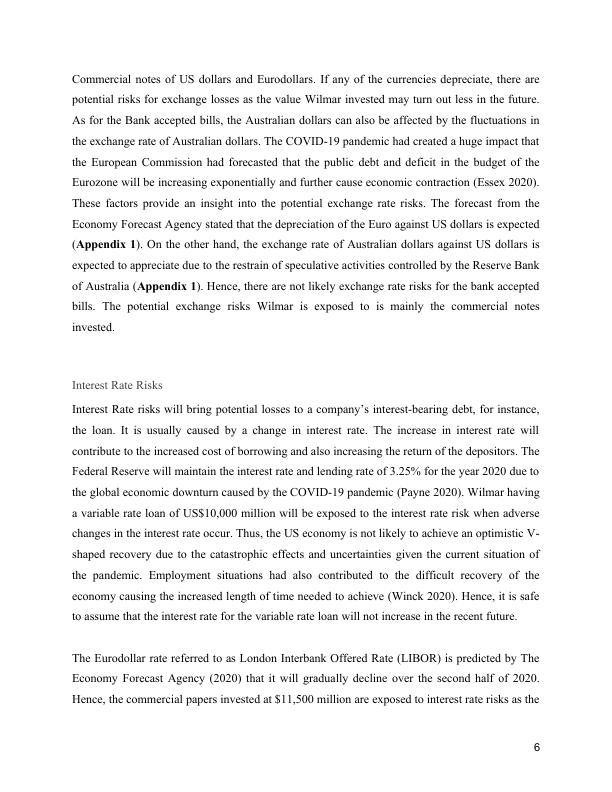Report on Analysis of Financial Risk of Wilmar International Limited
28 Pages4590 Words27 Views
Added on 2022-03-03
About This Document
One of Asia's top agricultural businesses is Wilmar International Limited. The company is based in Singapore, where it was created. The exposed financial risks in the operation of the company growing palm oil across Asia and Africa will be the main subject of this study. In order to reduce the possibility of suffering possible losses, this study tries to identify all potentially important financial risks and recommend suitable hedging measures to the organisation.
Report on Analysis of Financial Risk of Wilmar International Limited
Added on 2022-03-03
ShareRelated Documents

Executive Summary
The report is served to display an overview of the exposure of financial risks faced by Wilmar
International Limited. Appropriate hedging strategies are then proposed to suit the company.
There will be three sections of the report. In the first section, identified financial risks will be
explained in detail, which are interest rate risks, equity risks, and also foreign exchange risks.
Next, the recommendations suggested for Wilmar are to hedge partially on equity risks, hedging
fully on the commercial papers for interest rate risks and currency risks, but not hedging on BAB
and variable rate loans.
In the second section, Wilmar is recommended to utilize the derivative instruments provided by
CME Group such as futures contracts to hedge equity and interest rate risks, while options
contract is used to hedge the exchange rate risks. By utilizing the hedge, Wilmar can reduce the
potential losses to a minimum level. Besides, an analysis table is provided to indicate how the
company hedges against the risk faced for hedging fully on the commercial papers.
In the last section, option combination strategies provided are recommended to Wilmar. Wilmar
is suggested to hedge against the risk of Sterling Equities of £700 million with the bear put
spread strategy and also the long straddle strategy.
2
The report is served to display an overview of the exposure of financial risks faced by Wilmar
International Limited. Appropriate hedging strategies are then proposed to suit the company.
There will be three sections of the report. In the first section, identified financial risks will be
explained in detail, which are interest rate risks, equity risks, and also foreign exchange risks.
Next, the recommendations suggested for Wilmar are to hedge partially on equity risks, hedging
fully on the commercial papers for interest rate risks and currency risks, but not hedging on BAB
and variable rate loans.
In the second section, Wilmar is recommended to utilize the derivative instruments provided by
CME Group such as futures contracts to hedge equity and interest rate risks, while options
contract is used to hedge the exchange rate risks. By utilizing the hedge, Wilmar can reduce the
potential losses to a minimum level. Besides, an analysis table is provided to indicate how the
company hedges against the risk faced for hedging fully on the commercial papers.
In the last section, option combination strategies provided are recommended to Wilmar. Wilmar
is suggested to hedge against the risk of Sterling Equities of £700 million with the bear put
spread strategy and also the long straddle strategy.
2

3

Introduction
Wilmar International Limited, one of the largest leading agribusiness companies in Asia. The
company is founded and headquartered in Singapore. This study will be focusing on the exposed
financial risks in the operation of the business cultivating palm oil across Asia and Africa. This
report aims to identify all potentially relevant financial risks and suggest appropriate hedging
techniques to the company to minimize the chances of making potential losses. Future contracts,
forward contracts, or option contracts will be used as the derivative instruments for the hedging
techniques. The data used for the derivative instruments like futures prices and option prices are
retrieved from the website of CME Group and Barchart.com to ensure the reliability and
accuracy of the report.
4
Wilmar International Limited, one of the largest leading agribusiness companies in Asia. The
company is founded and headquartered in Singapore. This study will be focusing on the exposed
financial risks in the operation of the business cultivating palm oil across Asia and Africa. This
report aims to identify all potentially relevant financial risks and suggest appropriate hedging
techniques to the company to minimize the chances of making potential losses. Future contracts,
forward contracts, or option contracts will be used as the derivative instruments for the hedging
techniques. The data used for the derivative instruments like futures prices and option prices are
retrieved from the website of CME Group and Barchart.com to ensure the reliability and
accuracy of the report.
4

Section I
(A) Financial Risk Exposures
Equity Price Risk
Wilmar is exposed to equity price risks as the investment portfolio displayed a significant
amount invested in the S&P 500 and FTSE 100. The portfolio beta of a particular stock shows
the comparison between the volatility of the stock and the volatility of the market (Lemke 2020).
Hence, a stock is said to have higher volatility than the market when the portfolio beta is greater
than 1.0. According to the investment portfolio, the S&P 500 shows a portfolio beta of 1.5, while
FTSE100 shows a portfolio beta of 1.0. It means that the stock price for the S&P 500 is 50%
more volatile than the market index. On the other hand, the stock price from FTSE100 shows the
same volatility as the market index. In this situation, the S&P 500 investment has a high price
fluctuation which incurs potential risks for Wilmar to lose money from this investment. For
FTSE100, the beta value of 1.0 suggests that the stock price activity is strongly correlated to the
market. Hence, there are only systematic risks for the stock. Investing in a stock with a portfolio
beta of 1.0 will not bring risks to the investment portfolio. However, the likelihood of the stock
providing an excess return is also minimum. Onali (2020) claims that the constantly increasing
cases of the COVID-19 pandemic had triggered the high volatility in stock prices, which triggers
the possibility of stock prices falling in the future. The uncertainties arising from the pandemic
recently may affect the stock market further, causing a constant falling of prices (Dillon 2020).
The stock price of the S&P 500 and FTSE100 is expected to fall soon, which means that the
value in the future will be lesser. Even though the risks for FTSE100 are comparatively lower,
the stock price still follows the market trend of falling. Hence, potential losses are expected for
both equity investments.
Exchange Rate Risks
The risks caused by the exchange rate fluctuations will directly affect the profit and loss of
overseas trade and investment. Currency risks may incur losses when the movement of the
exchange rate is adverse (Chen 2020). For Wilmar, investments of relatively huge amounts in
5
(A) Financial Risk Exposures
Equity Price Risk
Wilmar is exposed to equity price risks as the investment portfolio displayed a significant
amount invested in the S&P 500 and FTSE 100. The portfolio beta of a particular stock shows
the comparison between the volatility of the stock and the volatility of the market (Lemke 2020).
Hence, a stock is said to have higher volatility than the market when the portfolio beta is greater
than 1.0. According to the investment portfolio, the S&P 500 shows a portfolio beta of 1.5, while
FTSE100 shows a portfolio beta of 1.0. It means that the stock price for the S&P 500 is 50%
more volatile than the market index. On the other hand, the stock price from FTSE100 shows the
same volatility as the market index. In this situation, the S&P 500 investment has a high price
fluctuation which incurs potential risks for Wilmar to lose money from this investment. For
FTSE100, the beta value of 1.0 suggests that the stock price activity is strongly correlated to the
market. Hence, there are only systematic risks for the stock. Investing in a stock with a portfolio
beta of 1.0 will not bring risks to the investment portfolio. However, the likelihood of the stock
providing an excess return is also minimum. Onali (2020) claims that the constantly increasing
cases of the COVID-19 pandemic had triggered the high volatility in stock prices, which triggers
the possibility of stock prices falling in the future. The uncertainties arising from the pandemic
recently may affect the stock market further, causing a constant falling of prices (Dillon 2020).
The stock price of the S&P 500 and FTSE100 is expected to fall soon, which means that the
value in the future will be lesser. Even though the risks for FTSE100 are comparatively lower,
the stock price still follows the market trend of falling. Hence, potential losses are expected for
both equity investments.
Exchange Rate Risks
The risks caused by the exchange rate fluctuations will directly affect the profit and loss of
overseas trade and investment. Currency risks may incur losses when the movement of the
exchange rate is adverse (Chen 2020). For Wilmar, investments of relatively huge amounts in
5

Commercial notes of US dollars and Eurodollars. If any of the currencies depreciate, there are
potential risks for exchange losses as the value Wilmar invested may turn out less in the future.
As for the Bank accepted bills, the Australian dollars can also be affected by the fluctuations in
the exchange rate of Australian dollars. The COVID-19 pandemic had created a huge impact that
the European Commission had forecasted that the public debt and deficit in the budget of the
Eurozone will be increasing exponentially and further cause economic contraction (Essex 2020).
These factors provide an insight into the potential exchange rate risks. The forecast from the
Economy Forecast Agency stated that the depreciation of the Euro against US dollars is expected
(Appendix 1). On the other hand, the exchange rate of Australian dollars against US dollars is
expected to appreciate due to the restrain of speculative activities controlled by the Reserve Bank
of Australia (Appendix 1). Hence, there are not likely exchange rate risks for the bank accepted
bills. The potential exchange risks Wilmar is exposed to is mainly the commercial notes
invested.
Interest Rate Risks
Interest Rate risks will bring potential losses to a company’s interest-bearing debt, for instance,
the loan. It is usually caused by a change in interest rate. The increase in interest rate will
contribute to the increased cost of borrowing and also increasing the return of the depositors. The
Federal Reserve will maintain the interest rate and lending rate of 3.25% for the year 2020 due to
the global economic downturn caused by the COVID-19 pandemic (Payne 2020). Wilmar having
a variable rate loan of US$10,000 million will be exposed to the interest rate risk when adverse
changes in the interest rate occur. Thus, the US economy is not likely to achieve an optimistic V-
shaped recovery due to the catastrophic effects and uncertainties given the current situation of
the pandemic. Employment situations had also contributed to the difficult recovery of the
economy causing the increased length of time needed to achieve (Winck 2020). Hence, it is safe
to assume that the interest rate for the variable rate loan will not increase in the recent future.
The Eurodollar rate referred to as London Interbank Offered Rate (LIBOR) is predicted by The
Economy Forecast Agency (2020) that it will gradually decline over the second half of 2020.
Hence, the commercial papers invested at $11,500 million are exposed to interest rate risks as the
6
potential risks for exchange losses as the value Wilmar invested may turn out less in the future.
As for the Bank accepted bills, the Australian dollars can also be affected by the fluctuations in
the exchange rate of Australian dollars. The COVID-19 pandemic had created a huge impact that
the European Commission had forecasted that the public debt and deficit in the budget of the
Eurozone will be increasing exponentially and further cause economic contraction (Essex 2020).
These factors provide an insight into the potential exchange rate risks. The forecast from the
Economy Forecast Agency stated that the depreciation of the Euro against US dollars is expected
(Appendix 1). On the other hand, the exchange rate of Australian dollars against US dollars is
expected to appreciate due to the restrain of speculative activities controlled by the Reserve Bank
of Australia (Appendix 1). Hence, there are not likely exchange rate risks for the bank accepted
bills. The potential exchange risks Wilmar is exposed to is mainly the commercial notes
invested.
Interest Rate Risks
Interest Rate risks will bring potential losses to a company’s interest-bearing debt, for instance,
the loan. It is usually caused by a change in interest rate. The increase in interest rate will
contribute to the increased cost of borrowing and also increasing the return of the depositors. The
Federal Reserve will maintain the interest rate and lending rate of 3.25% for the year 2020 due to
the global economic downturn caused by the COVID-19 pandemic (Payne 2020). Wilmar having
a variable rate loan of US$10,000 million will be exposed to the interest rate risk when adverse
changes in the interest rate occur. Thus, the US economy is not likely to achieve an optimistic V-
shaped recovery due to the catastrophic effects and uncertainties given the current situation of
the pandemic. Employment situations had also contributed to the difficult recovery of the
economy causing the increased length of time needed to achieve (Winck 2020). Hence, it is safe
to assume that the interest rate for the variable rate loan will not increase in the recent future.
The Eurodollar rate referred to as London Interbank Offered Rate (LIBOR) is predicted by The
Economy Forecast Agency (2020) that it will gradually decline over the second half of 2020.
Hence, the commercial papers invested at $11,500 million are exposed to interest rate risks as the
6

End of preview
Want to access all the pages? Upload your documents or become a member.
Related Documents
Understanding VIX Futures and Optionslg...
|8
|2079
|312
Risk Management Derivativeslg...
|22
|5964
|110
TTY Corporation: A Dividend Payerlg...
|6
|677
|330
Benefits And Limitations of Hedging Analysislg...
|8
|1533
|18
Derivativeslg...
|7
|962
|368
Financial risk management Assignmentlg...
|4
|619
|41
